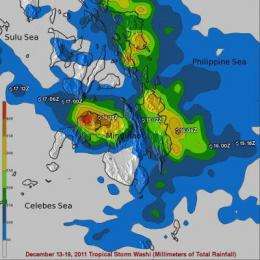NASA's TRMM satellite measured Washi's deadly rainfall

NASA's Tropical Rainfall Measuring Mission (TRMM) satellite was providing forecasters with the rate in which rainfall was occurring in Tropical Storm Washi over the last week, and now TRMM data has been compiled to show rainfall totals over the devastated Philippines.
Washi, known locally in the Philippines as Sendong, began as a tropical depression on December 13, 2011 in the West Pacific Ocean about 2150 km (~1333 miles) due east of the southern Philippines. Washi only intensified slightly and never exceeded tropical storm intensity as it tracked due west towards the southern Philippines' island of Mindanao.
Washi made landfall on the east coast of Mindanao on the afternoon of Dec. 16 as a moderate tropical storm with sustained winds reported at 55 knots (~63 mph). Despite its modest intensity, Washi had a huge impact on the island. As Washi made its way across Mindanao, it dumped heavy rains over parts of the island, which in turn triggered flash floods and mudslides. These turned out to be catastrophic as over 900 people were killed with hundreds more reported missing when entire villages where swept away.
Rainfall estimates from the TRMM-based, near-real time Multi-satellite Precipitation Analysis (TMPA) at the NASA Goddard Space Flight Center, Greenbelt, Md. were compiled for the period of Dec. 13 to 20, 2011 for the southern Philippines. TRMM is a joint mission between NASA and the Japanese space agency JAXA.
Rainfall totals are on the order of 200 to over 250 mm (~8 to 10 inches) along Mindanao's east coast where Washi made landfall, but the highest amounts are along the northwest coast, where totals are on the order of 300 to over 400 mm (~12 to over 16 inches). To put the rainfall in perspective, 16 inches is the equivalent of about four months of rainfall in Washington, D.C.
In the southern Philippines places like Cagayan de Oro City and Iligan City suffered the most devastating mudslides. In addition to deforestation and weak construction, poor warnings are being blamed for the deadliest cyclone disaster to hit the Philippines in three years. The residents of the southern Philippines see far fewer cyclones per year than in the north, and most of the heavy rain was reported to have fallen over the mountains before flowing down in raging rivers.
Provided by NASA's Goddard Space Flight Center





















